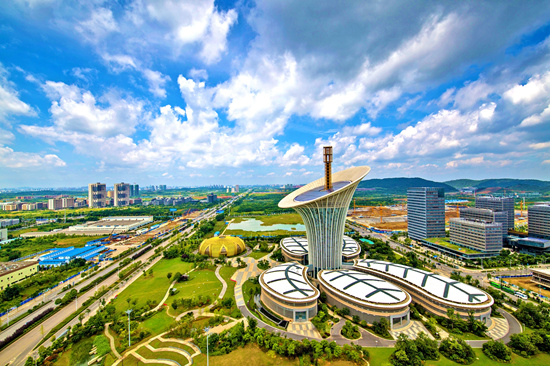How the CPC has transformed China’s economic fortunes

Even as the world marvels at the revolutionary governance of the Communist Party of China (CPC) which marks a hundred years on July 1, there is one major success story that stands out from the rest. This is the unprecedented economic growth that has made China the second largest economy in four decades.
Ever since the CPC kicked off the Reform and Opening Up policy in 1978 that ushered China into the global marketplace, the country has risen to a global economic powerhouse and is second only to the U.S. According to a report released by the UK-based Centre for Economics and Business Research in December 2020, China will overtake the US to become the world's largest economy by 2028, five years earlier than previously forecast.
Despite the grave and complex challenges posed by the COVID-19 pandemic, China managed to bring its economic growth back to a pre-pandemic rate, the only major economy in the world that recorded positive economic growth. Its full-year Gross Domestic Product (GDP) was more than 100 trillion yuan (US dollars 15.45 trillion) for the first time.
China has recorded a V-shaped recovery curve, making it the major driving force in the recovery of the global economy. The country's GDP dipped 6.8 percent year-on-year in the first quarter of 2020 before making a comeback of 3.2 percent in the April-June quarter. It then recorded a 4.9 percent rise in the third quarter and extended the rising streak from October through December by moving upward 6.5 percent.
Consequently, China's economy is now tipped to command around 17 percent of the global economy. Indeed, figures do not lie as shown by the following facts and figures released by China’s National Bureau of Statistics on February 28:
- GDP grew 2.3 percent year-on-year to hit 101.6 trillion yuan (about $15.7 trillion) in 2020. From a 6.8-percent contraction in Q1, 3.2-percent expansion in Q2, 4.9-percent recovery in Q3 to a 6.5-percent rebound in Q4, the V-shaped trajectory made China the only major economy to log positive growth.
- New economic drivers continued to grow, with the tertiary industry sector accounting for 54.5 percent of GDP.
- A total of 11.86 million new urban jobs were created in 2020, with the surveyed urban unemployment rate at 5.2 percent by the end of the year.
- Foreign direct investment into the Chinese mainland, in actual use, expanded 6.2 percent year-on-year to about 1 trillion yuan in 2020.
- China's consumer price index, a main gauge of inflation, rose 2.5 percent year-on-year in 2020. The producer price index, which measures cost of goods at the factory gate, fell 1.8 percent.
- China's grain output reached nearly 670 billion kg in 2020, up 5.65 billion kg or 0.9 percent from a year earlier.
- China's total imports and exports of goods expanded 1.9 percent year-on-year to 32.16 trillion yuan in 2020.
- China's foreign exchange reserves expanded to $3.2165 trillion at the end of 2020. Yuan's average exchange rate against the US dollar came in at 6.8974, appreciating 0.02 percent from a year earlier.
- China lifted its remaining 5.51 million impoverished rural residents out of poverty in 2020, making it the only country in the world to eradicate absolute poverty.
- Research and development expenditure increased 10.3 percent to over 2.44 trillion yuan, accounting for 2.4 percent of GDP.
- 59.9 percent of the 337 cities monitored achieved air quality standards.
- The number of successful space launches came in at 35, including China's Chang'e 5 probe that brought back lunar samples.

The above and other major achievements are obviously not accidental. They are as a result of well thought out policies by the country’s leadership which has placed China on a steep upward trajectory. The country has put innovation high on its agenda, making it one of the key drivers of social and economic development.
Official data shows value-added output by China's high-tech manufacturing sector recorded a 5.9-percent growth in the first three quarters of 2020, 4.7 percentage points higher than the overall industrial output growth.
According to the CPC’s Central Committee's development proposals made public in late October, China is now pursuing innovation-driven development to help it shape new development advantages. This includes upholding the central role of innovation in its modernization drive and basing self-reliance in science and technology as the strategic underpinning for national development.
But even as China is set to lead the world’s economy, it is now undergoing a paradigm shift. This is the launch of the "dual circulation economy", a concept that was introduced during the fifth plenary session of the 19th Central Committee of the CPC be held in Beijing from October 26 to 29 in a session that discussed the 14th five-year plan.
The new policy has two equally strong components: "internal circulation," which refers to domestic economic activities, and "external circulation," which relates to China's economic links with the outside world. Basically, the aim is to reduce the role of international trade in its economy, and strengthen its domestic economy.
First, this will cushion the country’s economy from external shocks like the ongoing COVID-19 pandemic. Secondly, the policy will protect China from America’s malicious intention by sabotaging the country’s economy by decoupling and alienating it from global supply chains.
But this does not mean that China will not continue its reform and opening up economic agenda. The rollout of these measures in 2020, including signing of the landmark Regional Comprehensive Economic Partnership and the conclusion of negotiations for the China-EU investment treaty in 2020 demonstrates China's determination to open its domestic market to the world and engaging in the world economic system for the benefit of consumers globally.





